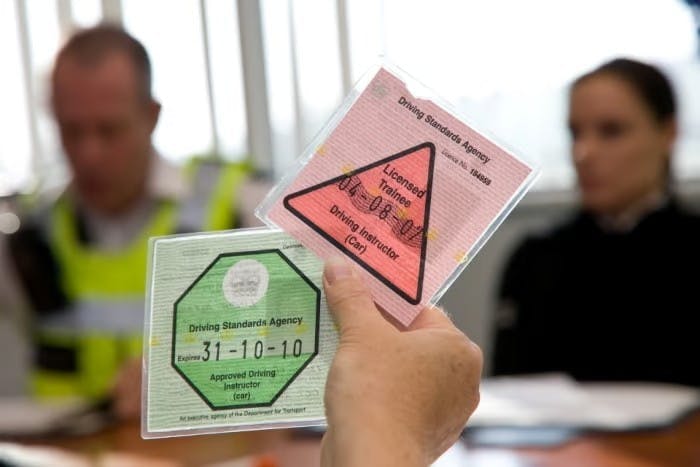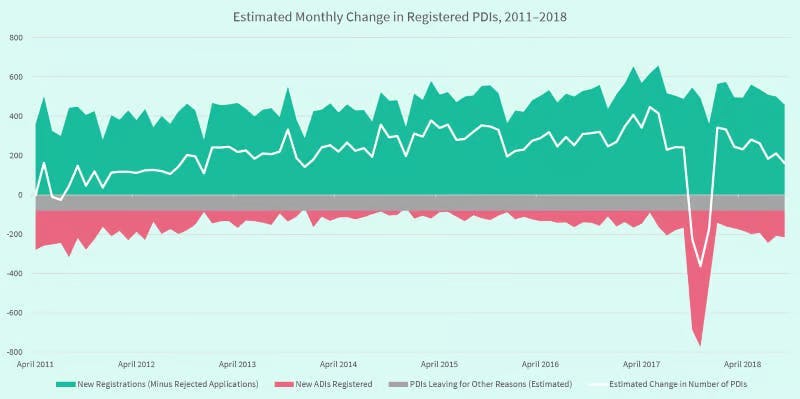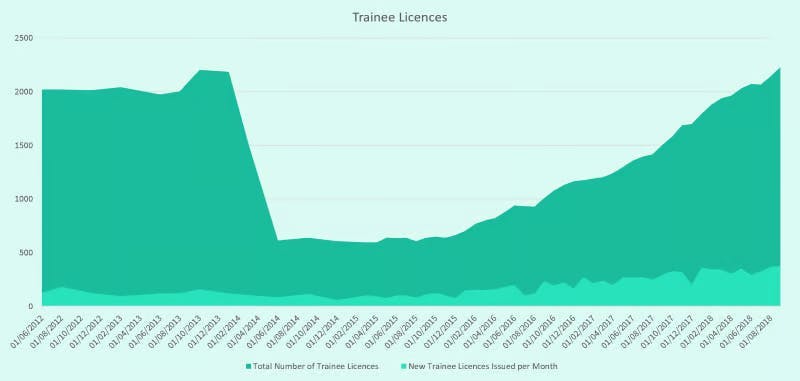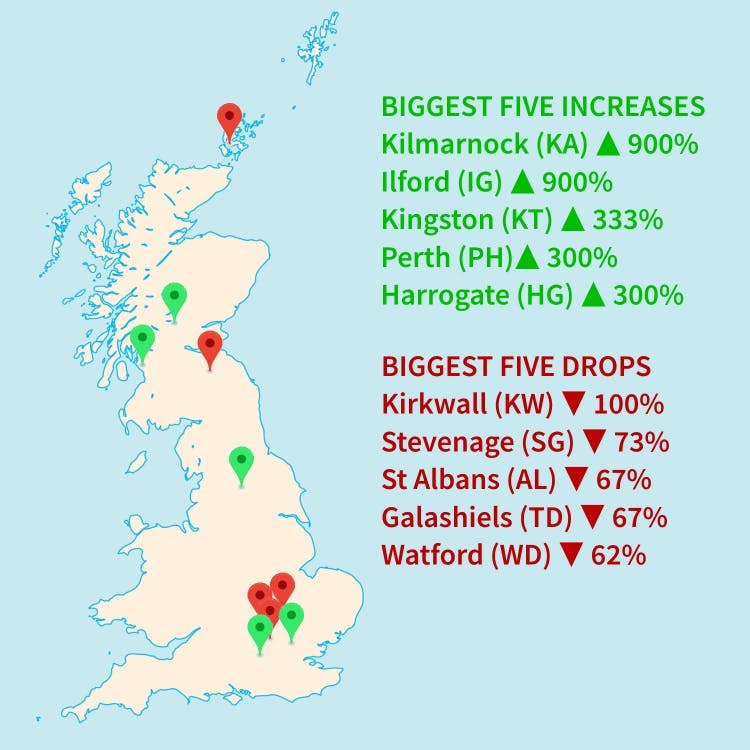The journey to becoming a driving instructor takes time. Between first registering your interest with the DVSA and receiving your full ADI badge, you'll need to sit three tests, and may spend up to six months practising on a trainee licence. Throughout this process, you're known as a Potential Driving Instructor, or PDI.
With would-be instructors making new applications and those who've passed all three tests graduating to ADI status, the number of PDIs is constantly in flux. This can make it tricky to work out how many PDIs are currently operating at the moment. Using official data from the DVSA, however, we've put our hand to examining PDI stats over time.
About PDIs
Before we take a look at the stats, let's take a minute to define what exactly a PDI is.
- Firstly, in order to apply to become a PDI, you must have held a full car driving licence for at least three years and be aged 21 or over. If you hold an automatic licence, you'll only be able to teach in an automatic car.
- Your application may be refused if you are found not to be 'fit and proper', a judgement which takes into account your personal conduct and requires you to undergo a criminal record check.
- If your application is accepted, you're now a PDI. Before you can start teaching students as a trainee on a paid basis, however, you'll need to pass a theory (part 1) test and a practical (part 2) test.
- After this, and provided you've taken at least 40 hours of training from an ADI in offering driving instruction, you have the option to apply for a trainee licence, which lasts for six months and allows you to get paid for instruction.
- The final step is to take the ADI part 3 test, which examines your instructional ability. Pass this test, and you'll become an Approved Driving Instructor!
How many PDIs are there?
Working out an exact number of PDIs can be a tricky business. That's because being a PDI is meant to be, by its definition, a transitional period, with new registrations offset by those 'graduating' to ADI status.
Making matters more difficult is that the DVSA hasn't provided up-to-date figures on the number of PDIs on the road since September 2012. At the time, the DVSA held details on 97,647 potential driving instructors.
This may seem like an unexpectedly large number—but it reflects the reality that, while becoming a PDI simply involves applying and being accepted, becoming an ADI is much more difficult. Many drop out at various stages of the process—some after failing one or more tests; others without taking any. Indeed, the DVSA notes that “most [PDIs whose details they hold] will no longer be pursuing a career as a driving instructor”.
One alternative is to check the number of trainee licence-holders on the road—a figure which the DVSA has kept more up to date. The latest data, from September 2018, showed that there were 2,228 PDIs with trainee licences. It's worth remembering some key facts, though. First, you can only get a trainee licence after having passed the ADI part 1 and part 2 tests. Secondly, there's no requirement to ever apply for a trainee licence. This means that this figure represents only a small fraction of registered PDIs.
Why would the number of PDIs change over time?

With no updated figures on the number of PDIs since 2012, working out how PDI stats have changed over time isn't the simplest of tasks. Nonetheless, we can try out a little sleuthing to see if we can come up with a reasonable estimate.
We have one key fact to work with as a starting point: the 97,647 PDIs on the register in September 2012. Using this as a base, we can then try and figure out how many have either become or ceased to be a PDI in the intervening years. This means taking into account:
- Anyone who applied to become a PDI, minus any rejected applications
- Those who became ADIs, thus leaving the PDI register
- PDIs who were are no longer on the register for other reasons
The first two points here are pretty easy to track—the DVSA has provided month-by-month data for them dating back to 2011. However, the numbers removed from the register for other reasons aren't clear. While the DVSA do provide some reasons why someone may be removed from the register of PDIs (such as no longer meeting the standards of being a 'fit and proper' person) it's not clear whether they'll remove any other records—e.g., anyone whose application hasn't been updated for a certain period.
We don't have very much data to go off to work this out—but we can look at figures from between October 2011 and September 2012. Over this time period:
- The number of registered PDIs increased by 1,358
- There were 4,966 new applications to become a PDI
- 270 of applications were rejected, leaving us with 4,696 new PDIs
- Meanwhile, 2,436 PDIs became ADIs
Using these figures, we can spot a 'gap' of around 900 PDIs who must have left the register over this 11-month period, but didn't become an ADI. These include those removed by the registrar, with other potential reasons including voluntary deregistration and removal of records of PDIs who have passed away. As these figures are likely to be relatively constant, we can assume that the number of PDIs deregistered for these reasons will be similar each year.
How has the number of PDIs changed over time?
While we can't provide 100% accurate figures on how the number of PDIs has changed, we can, by combining our assumptions above with the data we do have, come up with a reasonable estimate.
In this graph, the white line shows how, month by month, the number of PDIs has grown (or shrunk). We can see that, the vast majority of the time, the number of new PDIs vastly outnumbers those leaving the register. The only glaring exception is in late 2017, when a glut of new ADI registrations meant that the number of PDIs fell significantly.
What does all of this mean in real terms, though? Well, we estimate that, when you balance out the numbers joining with those leaving, the PDI register grows by an average of 213 individuals per month. So, how does that impact on the total number of PDIs? Let's take a look.

Our estimates show steady growth over the period we're looking at—again, the only noticeable dip is in late 2017. If our forecasts are correct, the number of PDIs on the register has increased from 97,647 at the start of September 2012 to 115,276 six years later. This would mean that the register is growing by around 3% per year.
What about the number of trainee licence-holders?
As we've noted, most PDIs on the register aren't in the process of becoming driving instructors. If you're a learner driver, then, the type of PDI you're most likely to encounter is one with a trainee licence, as people with this licence are entitled to provide paid driving instruction.
Unlike PDI status, a trainee licence is not indefinite. In fact, its validity is just six months, and the DVSA are reticent to offer trainee licences to PDIs more than once. After all, you're meant to be using it to build up your experience ahead of a part 3 exam, not offer tuition continuously without having passed.
Since everyone with a trainee licence is (presumably) actively teaching students, the DVSA offers much more thorough data on this category of PDIs. We've compiled this into the graph below, which offers a month-by-month breakdown of the numbers of new trainee licences, together with the total number of trainee licence-holders at that time.

As can be seen, numbers remained fairly static until early 2014, when there was a sharp dip. It's not entirely clear why this was the case, though it may be linked to 2013 Government proposals to replace the trainee licence with “a requirement for trainee instructors to be accompanied by ADIs when providing paid instruction”.
In reality, these proposals never came into effect, and the number of trainee licences eventually rose back to their previous levels. Indeed, September 2018 saw both the most new trainee licences granted of any month, at 372, as well as the highest total number of trainee licence-holders on record, at 2,228.
However, these increases haven't been evenly spread across the country. Just as the number of ADIs by area can vary dramatically, so too can the number of trainee licence-holders. The DVSA offers postcode area-level data going back to June 2012, which shows huge increases in some locations with massive drops elsewhere. We've taken a look at some of the extremes in the map below.

This map shows some of the biggest shifts in percentage terms between June 2012 and September 2018. We can see, for example, that Kirkwall, which once had 25 trainee licence-holders, had none in the most recent data. Kilmarnock and Ilford both saw increases from just 1 in 2012 to 10 in 2018.
Though not shown on the map, the biggest leap in purely numerical terms was seen in the Manchester area, which went from 37 trainee licences in 2012 to 77 six years later. Going in the opposite direction was south-east London, which dropped from 56 to 24.
How well are PDIs performing on tests?
Of course, the one thing all of these stats ignore is that the whole point of being a PDI is that, eventually, you'll go on to become an ADI. It may be true that large numbers of those who start the process don't end up finishing it, but it's interesting to see how PDIs who took their tests actually fared.
As you'll remember, there are three tests that a PDI must pass in order to become an ADI: part 1, a theory test; part 2, a practical test; and part 3, which tests instructional ability. The DVSA doesn't offer up-to-date pass rates for the part 1 test—the most recent data, from an FoI request dating to 2011, suggested that this stood at around 50%. We can, however, take a look at pass rates for both parts 2 and 3 over recent years.

The pass rate for part 2 has generally hovered somewhere above 50% for most of the past decade, rising from a low of 47.8% in 2007/08 to a high of 56.9% in 2015/16, before dropping slightly. This test is, essentially, a stricter version of the practical test any driver must sit to get on the road, so it's not surprising to see that not everyone passes.
Part 2 pass rates are, however, considerably above those for part 3. This is also understandable—an instructional ability test is something that has no obvious parallels, so it's likely many candidates are thrown by it and let nerves get the better of them. Pass rates here are slowly on the up too, though, having risen from their 2007/08 nadir just 26.9% to 2017/18's 36.1%.
Interestingly, men and women have different strengths here. In every year on record, men have outperformed women on the part 2 test, while the reverse has been the case for part 3. In the most recent figures from 2017/18, the stats were as follows:
Men
Women
Overall
Part 2
56.3%
50.0%
54.3%
Part 3
34.9%
39.2%
36.1%
With men holding a similar lead over women in the standard practical test sat by all learner drivers, their strong performance in the part 2 test has precedent. However, despite the low numbers of female driving instructors on the road, it's women who dominate when it comes to instructional ability.
I'm interested in becoming an instructor—what do the stats mean for me?
With pass rates for part 3 tests looking fairly dismal, it's easy to get discouraged. If you're serious about becoming an instructor, though, there's no reason you can't beat the stats and start helping students in your area to get on the road. Read our article to find out whether you have what it takes to become an ADI. Ready to take on the road? Great news! We can help you to navigate your way from PDI to ADI status.
Subscribe for driving advice, offers & more
We'd love to let you know about our courses, news and offers via email. You may unsubscribe at any time.
Star Genie Limited trading as PassMeFast. Company number 10093359
Copyright © 2024 owned by Star Genie Limited
PassMeFast, Blue Tower, MediaCityUK, Salford, M50 2ST

